Reader defines the limits of dog love
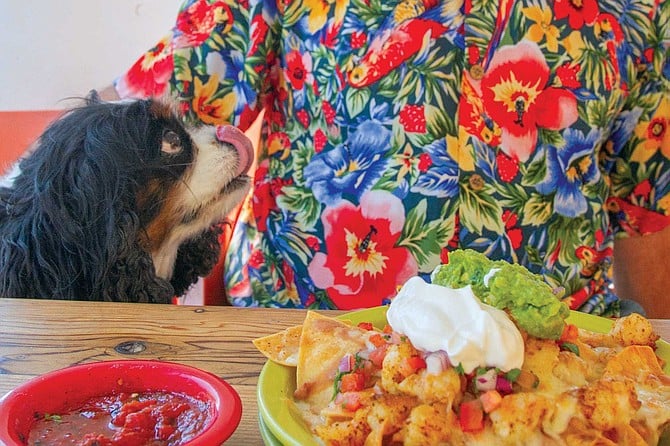
“I take them most everywhere I can. Why? Because they are chill, behaved and not aggressive.”
Murphy is an eleven-year-old, second-generation golden doodle, jet black, whom my wife and I nicknamed Velcro because he sticks to our sides. Every the morning he rubs up against my wife or me, whoever gets up first, in the hopes of getting us to drop whatever we are doing and give him a can of premium farm-raised-beef dog food mixed with fresh vegetable puree. He gets walked daily, and receives plenty of attention throughout the day: lots of petting, belly rubs, and “good boy” platitudes.
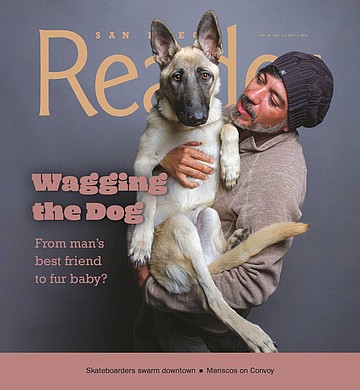
Photograph by Matthew Suárez
I love my dog, and my dog loves me. At least, he sure acts like it. And yet Murphy does not sleep in our bed. I would never, ever, refer to him as my “fur baby.” He’s never been to a pet spa or dog psychiatrist, he doesn’t have his own Instagram or Facebook page, and I don’t take him with me to The Home Depot, Vons, the local farmers market, or restaurants — even if the eatery offers an outdoor patio with water dishes and prominently displayed “dog friendly” signs. Dogs are not people, and I believe each has a proper place in our society.
But what I have come to realize is that by holding this position, I have set myself against what feels like the majority. Our society has become increasingly dog-friendly in recent years — to the point, I would argue, of humanization, or anthropomorphism, which the dictionary defines as “the attribution of human characteristics or behavior to a god, animal, or object.” Many other people do call dogs their “fur babies” and do take them along with them wherever they go. They throw lavish birthday parties for their dogs and give them their own social media pages. There are dog behaviorists, therapists and psychiatrists. There are pet spas and pet salons. And, as the New York Times observed in June 2018, “dog grooming…no longer means a flea bath and a clipping. Dogs are having their tresses colored, straightened, curled and waved. They’re getting mohawks and fauxhawks, lion cuts and teddy bear cuts. They’re volumizing with feathers and accessorizing with beads.” The Times reported that some dog owners are even buying prosthetic testicles for their neutered pets, courtesy of a company called Neuticles, to boost their self-esteem. One of that company’s clients was Kim Kardashian, who purchased a set of faux balls for her pet boxer.
Veteran San Diego dog breeder Tibor Lepes calls anthropomorphism “the bane of today’s dog world,” continuing, “As a dog enthusiast, I cringe at the relationship I observe on a daily basis. Our true relationship with dogs is symbiotic, and crucial in man’s evolution. Fat, useless creatures are not.”
But Elisa Stabile bristles at this comment. A real estate investor, Stabile is a single mom who became an empty nester last year when her only son went away to college. “I have one dog, a three-year-old Toy Aussie Shepherd named Frankie, and I call her my baby,” Stabile says. “She used to come with me to work when I had a job in corporate America; the company believes dog-friendly workplaces create happier employees, and a lot of people brought their pups. I have traveled with her cross-country twice, and she will travel with me by plane. My brother has dogs, and he takes them everywhere. We go to Pollo Maria’s (a nearby restaurant) every Friday night for family dinners. And my mom has a dog. She lives alone, and we credit that dog with keeping her active and emotionally stabile. Otherwise, her loneliness would be devastating to her.”
Dog ownership, Stabile says, “is really a very critical factor in many people’s emotional and mental well-being. I, for one, can say that having a dog has helped me get through the grieving process of losing both my father and my close friends. It also has helped me with empty-nesting and being a single person. If you ask me, dogs can make some people more ‘human,’ so why not humanize them?”
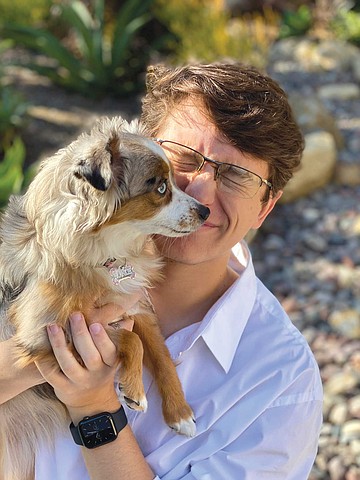
Dog ownership, Elisa Stabile says, “is really a very critical factor in many people’s emotional and mental well-being.” Her Toy Aussie Shepherd named Frankie is pictured here with her son who went away to college last year.
Photograph Courtesy Elisa Stabile
But while canine companionship is defintitely valuable, not all dog owners agree with Stabile’s conclusion. “Some dogs don’t have the confidence to be in a place that’s not their own, and that leads to stress, which can be a huge factor when they’re in that environment,” says Barbara Campbell, who lives with four Golden Retrievers who are regularly shown at dog shows and participate in obedience training. On top of that, one of her Goldens is the class mascot at a local elementary school. But no Home Depot for Campbell’s Goldens, nor Vons, nor dinner out at some restaurant. “My dogs want to be out sniffing bunnies and lizards on their walks or free runs, not stressed out or worrying about who’s going to give them treats,” she says. “It’s sad for the dog. And dogs can bite — it happened at Pizza Port, when a child went up to a dog on the patio and it bit her, in the face. There’s also a sanitation issue with grocery stores and carts. I wouldn’t want to put my food in a shopping cart that a dog — with possible urine or fecal matter or fleas — has used prior to me. And what if someone comes up and wants to pet your dog and it has ringworm? Most pet owners don’t know about all the things that dogs carry, and one of them is ringworm, which is very contagious — I got it one time.”
Campbell lives alone with her dogs, but they don’t share her bed. “Dogs are pack animals,” she says. “They sleep in crates, in a spare room I call the ‘dog room.’ It keeps them safe. They are den animals.” Campbell also says sleeping with dogs sends a wrong message. “You become part of the pack,” she says, “instead of the pack leader.”
Bill Baer agrees. A retiree, he and his wife are the proud owners of Finn, a nine-year-old rescue dog. “I take him out on walks and hikes, but I’m not going to bring him into a grocery store,” Baer says. “That’s too much – when you go into a place that sells food and you see all these fake service dogs…and some of these dogs aren’t small, either. It makes it hard to walk around, and you’re not sure what kind of temperament it’s got.”
Katrina Waidelich, a Carlsbad High School teacher, has two young children and two dogs: an old pug named Stitch and a young boxer, Ginger. She loves her dogs dearly, but doesn’t take them out into public places. “One thing I have seen, as a mom, is that when my children have had friends over for play dates, they do not react nicely to our dogs,” she says. “One friend has extreme anxiety — screaming, yelling, running away — and the other is very apprehensive. So when they come over, the dogs go away, so that the children can have a safe space and the run of the house. That’s why I don’t want to bring my dogs into public spaces, because I don’t know how kids are going to react.” As for grocery stores and restaurants, “I think it’s unsanitary. I don’t know if someone’s dogs are up to date on their vaccinations or have fleas or anxiety. And secondarily, I go to restaurants to relax and engage in conversations, and when I hear a dog barking profusely at every butterfly or child, it’s not a relaxing environment for me.”
Not surprisingly, Waidelich doesn’t refer to her dogs as her “fur babies.” “I have real babies, human babies,” she says. “They are not fur babies. They are pets. We have the responsibility to care for them, but no, they’re not fur babies.”
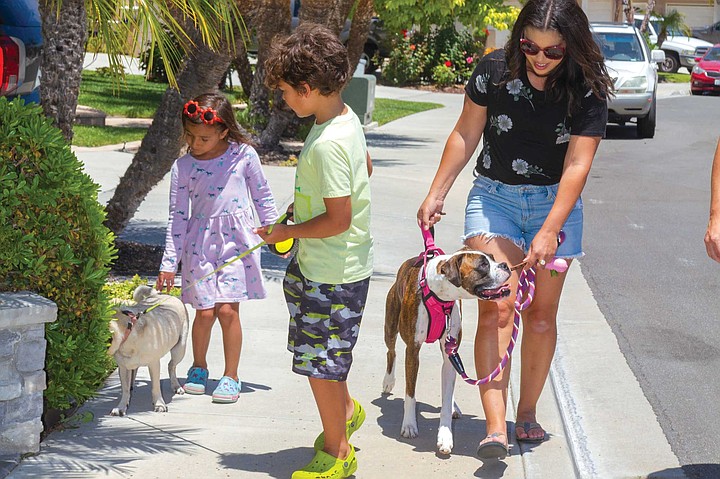
Katrina Waidelich, a Carlsbad High School teacher, has two young children and two dogs: an old pug named Stitch and a young boxer, Ginger. She loves her dogs dearly, but doesn’t take them out into public places.
Photograph by Matthew Suárez
Peter Meade, who runs his own marketing firm with his wife, owns two Cavalier King Charles Spaniels, Mr. Darcy and Lizzy. “I take them most everywhere I can. Why? Because they are chill, behaved and not aggressive. Both are graduates of Canine Good Citizenship training. Aggressive, poorly behaved dogs should not be in public. How many times have we left a restaurant in town and had people remark as we leave, ‘Oh, I didn’t know you had dogs with you!’ Why? Because they sit quietly under the table.” When there are issues, Meade says, “typically, fault lies with the owners. They are, like seemingly everyone these days, distracted (mainly by their phones), and the scenario is worsened by retractable leashes. Walking dogs properly is about maintaining control — for the sake of your dog as well as everyone else. I see a dog coming at us that is 10 or more feet from its owner who is yakking on his/her cell phone, and I know we’re in for trouble. ‘Oh, she’s/he’s friendly,’ the owner might say. Well, I don’t care. What if my dogs aren’t interested, or are scared by the dog charging at them?”
I reached out to fellow San Diegans on Facebook to get their thoughts on the matter.
An old classmate of mine who works at a local Home Depot – and who I won’t name in case his speaking out would get him in trouble with his company – wrote, “For starters, I own an awesome dog. My wife has one, too, and we own a cat. Where I work, they have a sign at the entrance that states pets are not allowed. But pet owners get obnoxious when you tell them their pet is not allowed unless it’s a service dog. Ninety-eight percent of them will lie and say theirs is, but they’re not. I’ve seen two co-workers bitten, one customer’s toy poodle almost killed by a Doberman, and dozens of dogs poop and pee in the store, with maybe five percent [of their owners] cleaning up after their dog. My wife and I go out to dinner or brunch at least once a week and I really dislike it when I see a dog enter. It’s not a petaraunt, it’s a restaurant – for humans. The humanization of dogs is ridiculously out of hand.”
Brian Stark, an engineer: “I love my dog (and cats), but I can’t stand the whole fur baby, pet parent thing. I’m OK with a well-behaved dog at an outdoor cafe or bar that allows it, but the place of business should set the policy. I’m sure it’s an insurance liability. Dogs can get stressed in unfamiliar settings and it’s normal for a stressed dog to act aggressively.”
Laurie Boone, a Carlsbad community leader: “I am so glad you are writing about this. I just spoke to an employee at Vons, asking why they allowed a giant dog into the store. She said they are afraid to say anything because of the attitudes then displayed by the dog owner. The dog was so tall that he was sniffing the food all through the vegetable section! I really like what Trader Joe’s has done. They have a large sign at the entrance that says, “We welcome service dogs, but no pets allowed for the comfort and safety of our customers.” I would suggest you look into the number of little children admitted to Rady Children’s due to dog bites. People have elevated dogs over humans. For goodness’ sake, we have happily spent lots of money on creating dog parks, but dog owners want every park to be a dog park…and every restaurant and every store. Oh my, I have stories too numerous to mention here.”
Ken Kaufman, an entrepreneur: “I take my dogs on walks, occasionally, to an outside brewery. But I went to a very expensive restaurant on Valentine’s Day, Milles Fleurs. A $700 bill, and next to me is a dog in a stroller. Staring at me. Needless to say, I will never go back. I don’t go to a fancy French restaurant to hang out with a dog. I love dogs more than people, but these entitled dog owners need to have common courtesy.”
Kevin Leap, an event organizer: I went to brunch [the other day] and a couple had their dog there and he was laying on the floor right in the path of the waitstaff. They didn’t seem to care and people nearly killed themselves getting around him. Not OK. I have two rescue pups and love them dearly. However, there is a time and a place, in my opinion.”
Dogs in restaurants appears to be a particularly hot-button issue for some, including restaurant owners. One told me that while he’s got a big outdoor patio where dogs are welcome, he’s doing so just to appease dog owners who might lash out and leave him a scathing Yelp review. “These people are entitled,” he says. “I’m OK with people bringing their dogs on a patio, as long as they are doing it respectfully. But that’s the whole point: They’re not. Their dogs run wild, they have long leashes, nobody has any common sense or respect anymore. We do allow dogs on our patio, but that doesn’t seem to be enough. I don’ t mind if the dog’s on a leash, under the table, discreetly there. But it’s ridiculous — it’s an attention-getter for people: ‘Oh, look at my dog, he’s so cute, look at little Fluffy.’”
In May, a Carlsbad resident posted a photo of a sign that went up at Le Papagayo, a restaurant in the North County town’s downtown “village.” “Dog owners are advised that the responsibility for your dog rests with you,” the sign read. “Dogs must be on a leash and controlled by their owners. Clean up is the owner’s responsibility. Dogs are not allowed on seats or tables, and must eat from designated bowls. Please recognize that while we love your dog, we are not here to umpire disputes between dogs, dogs and owners, or owners and owners. Thus, any unruly dogs and/or their owners will be asked to leave.” According to the post, “a server told us that after multiple problems, the last straw was when a server was severally inquired and put out of work — perhaps for good. A dog leash tripped her and she fell, shattering her shoulder and dropping over $100 worth of drinks.”
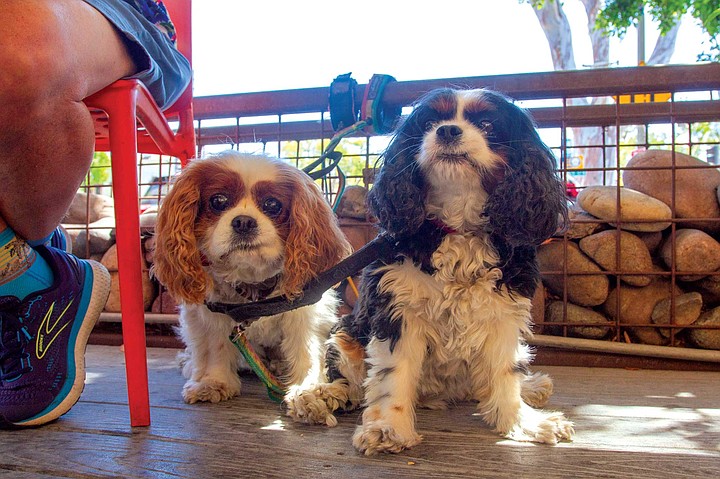
Peter Meade, who runs his own marketing firm with his wife, owns two Cavalier King Charles Spaniels, Mr. Darcy and Lizzy. Both dogs are graduates of Canine Good Citizenship training.
Photograph by Matthew Suárez
(A call to the restaurant to confirm the incident resulted in this: Vanessa, who said she was a manager, told me, “If it did happen, it happened prior to my employment here. A lot of our staff turns over here.”)
As a society, more of us are getting pets, and we’re spending more and more money on their care. According to the American Pet Products Association (APPA), spending on pets in the United States soared to an estimated $123.6 billion in 2021, more than twice as much as the $53.3 billion spent just ten years ago in 2012.
The 2021-2022 APPA National Pet Owners Survey found that 70{95b18eb6fc4f42efd0d92738dfc3fb79fde21da267a711ecdf0381147c27bb86} of U.S. households now own a pet, up from 56{95b18eb6fc4f42efd0d92738dfc3fb79fde21da267a711ecdf0381147c27bb86} in 1988, the survey’s first year. That equates to 90.5 million homes — and of those, 69 million homes have at least one dog. The most pet-friendly demographic is millennials, with thirty-two percent of young people in their twenties and thirties owning at least one pet, followed by Baby Boomers (twenty-seven percent) and Generation X (twenty-four percent). A company called Honest Paws recently surveyed 400 millennial women, and found that seventy percent of those who were childless consider their dog or cat as their child rather than as a pet. Seventy-two percent said they prefer the company of their pet over the company of a child.
None of this comes as a surprise to Dr. Richard Levak of Del Mar, a licensed clinical psychologist and nationally recognized personality expert who has been a guest on such programs as Larry King Live, 20/20, Nightline, Anderson Cooper, The Doctors, and True Crime with Aphrodite Jones. “There are people who spend thirty, forty thousand [dollars] on prolonging their dog’s life,” Levak says. “We’ve had friends who, literally, the dog had to be carried everywhere, because he could hardly walk — he’s blind, he’s walking into things, he’d pee on the wooden floor. And they just kept him.”
The anthropomorphism of dogs is a very real trend, Levak says. “And the question is why, why now, what’s happening now, why is it increasing? Is it our imagination, or is it happening? And certainly, anecdotally, you can see it happening. I think there are a number of issues. One is, there is a vast increase in loneliness, and you’ve seen a number of studies and articles that have been written about how people are increasingly lonely, for a number of reasons. One is Covid, and the other is social media and the tendency of people to be more isolated. And so loneliness is a pandemic — you can look that up. And I think that animals take that vacuum and fill it for people, so that [people] end up anthropomorphizing their animal because they are lonely and they need some kind of connection.”
Levak says millennials, in particular, are prone to humanizing their pets, especially their dogs, because they have been most affected by this sense of loneliness and isolation. “A lot of millennials are putting off having kids. They are into their careers or experiences, and I think also the last years of intense political conflict have given them a general sense that the world is just not a great place to bring up kids. And I’m hearing that from a number of my millennial and young adults: ‘Why would I have kids right now, bring them into world?’ So that kind of disillusionment with the world and the future and the loneliness makes people look for succor from an animal, and therefore ascribe human attributes to the animal and pamper them in a way that isn’t always best for the animal. Keeping a fifteen-year-old, blind, incontinent dog alive, and having teeth replacements and things…”
He pauses; then: “So you have this general sense of alienation and discouragement with the world, a sense of loneliness, isolation, and so people turn to animals…. And then they sort of lose their empathy or social responsibility. And I tell you, I don’t do it, I won’t do it, but people ask me all the time for a letter for a social support animal, so they can take them on an airplane. And I say, I don’t do that, because it kind of cheapens the people who really do need it.”
I ask Dr. Levak whether he thinks we are in a bubble, or whether this trend is going to continue, with ever-higher rates of pet ownership and more and more places where dogs are welcome. “That’s interesting question,” he replies. “Where will it end? At some point, how do we create rules? Because if we don’t, people will keep expanding. Once they identify with the dog as their child, they become protective and start demanding ever greater accommodations. Airlines have gotten fed up with it, because there are so many doctors writing notes… When it first started three or four years ago, a couple of my patients asked me, ‘I feel safer traveling with my dog; can you write me a letter so that I can take my dog on my trip to Europe?’ And I’d say, ‘OK, you are kind of anxious,,,’ But then, after it became a trend, I said, ‘No, I’m not doing that. It’s a scam. You’ve got to find a different way to deal with your anxiety.’”
Dr. Levak believes that at some point, the lines between a dog-child and a real child begin to blur in the pet owner’s mind. “People identify their dog’s behavior with human-like feelings and responses,” he says. “I think dogs have a good, well-developed limbic system. They do resonate with emotions, so if you’re in a room and there’s an argument and the voices get loud, the dog does resonate with the emotion, the intensity. They don’t have a strong neocortex, which is the ability to think and process. I think they make good pets because they are very emotionally in tune, so if the owner is sad, they will try to lick or get on a lap or something. And I think we have this emotional, I call it ‘affective hunger’ — we’re living in a time and a world in which we tend to get emotionally starved, and a dog meets that need. They will come up and lick you, they’re always happy to see you, they seem to sense when you are down and they want to come and connect with you. And then you project all sorts of things onto them. It does soothe you, it does, but it’s a reflection of the fact that we’re not creating as much community, so people are lonely, and dogs fill that gap. And then it becomes, increasingly, a parental protectiveness of your dog and your dog’s life.”
I feel obligated at this point to bring up an article in The Atlantic by science journalist Steve Budiansky. It was published in July of 1999, but it wasn’t brought to my attention until about four years ago. It has haunted me ever since. In the piece, which was titled “The Truth About Dogs,” Budiansky wrote, “Biologists, if they weren’t victims of the same blindness that afflicts us all, wouldn’t hesitate to classify dogs as social parasites. This is the class of manipulative creatures exemplified by the cuckoo, which lays its eggs in the nest of some poor unsuspecting dupe of a bird of another species. The befuddled parents see a big mouth crying out for food and stuff it full of worms at the expense of their own offspring. Every time they turn their backs, the cuckoo hatchling shoves another of their own flesh and blood overboard. The parents never seem to notice.”
Budiansky, whom I suspect might be a cat owner, writes that if we add up “all the benefits that dogs provide us and compare that sum with the costs, it is not a rational bargain on our part… In the past couple of years, new scientific evidence has started to confirm just how weird the relationship between dogs and human beings is — and how different it is from what we tend to think it is.”
He maintains that genetic research contradicts the long-held notion that early man domesticated dogs, and instead suggests the relationship developed the other way around: “Proto-dog found it in his interest to hang around people, and somehow persuaded them not to throw rocks at him or eat him.” He further claims that the huge population of dogs in today’s society provides “eloquent evolutionary testimony to the wisdom of mooching off people rather than fighting it out in the wild.” So it’s all an act, Budiansky says: dogs pretend to like us and are willing to protect us, but in truth they are merely acting in their own best interests.
The important thing to remember here is that this is just one man’s opinion. And yet, it makes you think. As I noted at the start of this article, my dog, Murphy, sure acts like he loves me. But deep down, I guess, I’m really not sure. I wonder what my “fur parent” friends would have to say about this…





